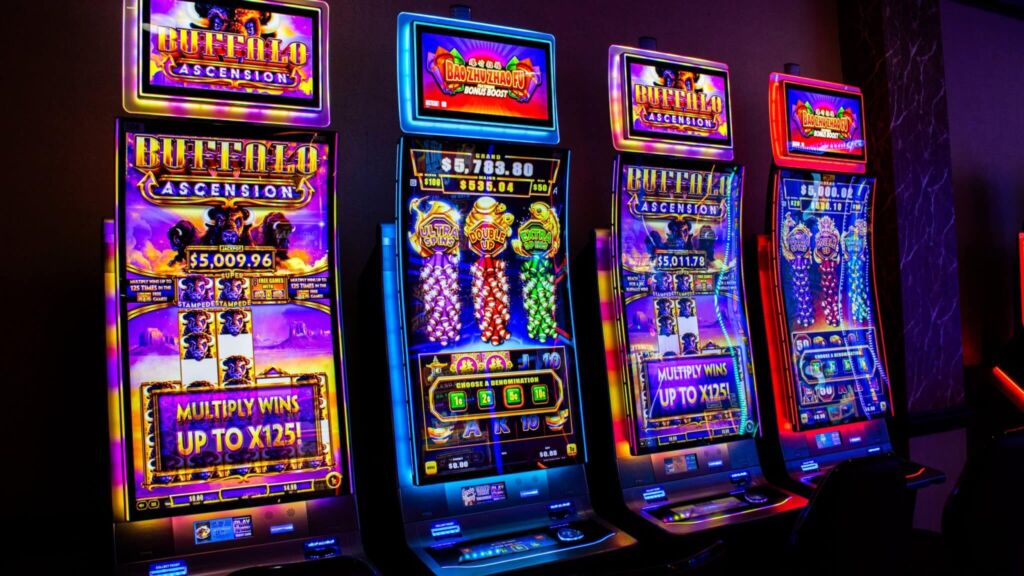Spanning from the late 19th century to present-day digital sophistication, the history of slot machines is a compelling travelogue through invention, chance, and the timeless charm of immediate wealth.
The Advent of Mechanical Wonder: From the Liberty Bell to Initial Breakthroughs
The narrative of slot machine origins begins in the late 1800s, amid significant industrial progress and a rising entertainment culture. Before this, several gambling apparatuses existed, but the invention that is often seen as the forerunner to modern slots is credited to Sittman and Pitt in 1891. Their creation was a five-reel machine, prominently featured in New York bars, that used playing card symbols. Players inserted a nickel, pulled a handle, and tried to make a winning poker hand. Since it didn’t have a direct payout system, winners usually got drinks or cigars as a prize, making it more of a peculiar amusement than straightforward betting.
Yet, the true predecessor of today’s slot machines came from the creativity of Charles Fey, a German mechanic based in San Francisco. In 1894, he designed the Liberty Bell, a simpler and more robust machine that changed the world of gambling. Unlike previous machines, it had three reels with five symbols - diamonds, hearts, spades, horseshoes, and the Liberty Bell. This simplicity improved its dependability and allowed for automatic payouts. Aligning three Liberty Bells won the jackpot, a significant advancement in design. Fey’s invention, along with its payout system, quickly became popular, setting a benchmark for future machines.
Though this success was transformative, Charles Fey did not patent his invention. This lack of protection, while it limited his financial gains, allowed other manufacturers to imitate and further develop the machine concept swiftly. By 1905, a Fey Liberty Bell machine unexpectedly showed up in the Mills Novelty Company’s factory in Chicago, evidencing the design’s rising fame and potential for profit. Companies like Mills Novelty took advantage of Fey’s unpatented design, creating their own versions and helping slot machines spread across not just the US, but worldwide. These early machines, constructed mainly from cast iron and featuring spinning reels, set the stage for today’s highly lucrative slot industry.
Electromechanical Period: The Emergence of 'Money Honey' and New Advancements
The mid-20th century marked crucial advancements in slot machine technology, shifting to electromechanical versions. Prior machines operated entirely on physical parts like springs and gears, but these new slots integrated electric components, automating reel movement and payout processes. Though these changes might seem minor, they opened up new possibilities in slot design and user enjoyment. A notable innovation from this time was the bottomless hopper, which made it possible to dispense larger wins automatically without needing someone to manually distribute coins.
In 1964, Bally Technologies, a prominent figure in the gaming industry, introduced 'Money Honey,' the first completely electromechanical slot. While retaining the familiar look of levers and reels, Money Honey utilized electric motors and solenoids, efficiently handling payouts as high as 500 coins by itself. This transition not only improved machine reliability and usability but also led to more intricate game designs and payout amounts. Designed with bright lighting and sounds specifically to draw attention to casino floors, Money Honey marked a turn towards more captivating and visually stimulating gambling experiences.
During this electromechanical period, there was a shift in the variety of symbols and themes on slot reels. Early machines had mainly card suits and bells, but manufacturers started introducing fruit symbols - like cherries and lemons - along with bars and sevens. This move towards using fruit imagery was partly due to legal reasons and was aimed at avoiding gambling restrictions, resulting in what became an iconic visual aspect of slot machines. Fruit machines gained particular popularity in the UK, adding fun visuals and making slots appeal more to a wider audience, beyond the traditional circles. These advancements set the groundwork for the next leap in technology: digital slots and video slot games.
Video Slot Revolution: Digital Screens and Improved Interaction
The transition into the digital era of the late 20th century marked a groundbreaking advancement in slot machine technology with the creation of video slots. Fortune Coin Co., which later became part of International Game Technology (IGT), developed the first video slot in 1976, initially installed at the Las Vegas Hilton. This innovation replaced mechanical reels with a video screen, displaying the game via digital simulation. Even though at first, players missed the tangible feel of spinning reels, video slots grew in popularity as technology advanced and designers explored the vast potentials offered by digital displays.
The move to video slots was monumental for many reasons. Firstly, it freed game designs from the limitations of mechanical constructions. Video displays could showcase multiple reels, paylines, and complex graphics and animations, providing a more engaging experience. They facilitated the introduction of novel elements like bonus games, multipliers, and progressive jackpots that mechanical slots couldn’t support. Bonus games added an interactive layer by taking players to new screens where they could win more rewards, injecting excitement into gambling. Meanwhile, progressive jackpots pooled bets from a network of machines, offering massive payouts and the allure of significant winnings. Video slot graphics enabled themed games inspired by cultural references, movies, and shows, increasing player interest and enlarging the audience.
IGT’s 'Wheel of Fortune' released in 1996 became emblematic of the emergence of video slots. Drawing from the beloved TV game, Wheel of Fortune incorporated sounds, animations, and a spinning bonus wheel capable of multiplying winnings. Its immense success highlighted the influence of branding and the integration of media in game design. Video slots didn’t just alter the gambling ecosystem but also augmented casino revenues dramatically. By offering rich features, higher potential payouts, and immersive play, they appealed to a varied crowd motivating prolonged gaming sessions. Thus, video slots solidified their place as the predominant form of slot machines in today’s casinos.
The Digital Era: Expanding Slots to Online and Mobile Platforms
The digital breakthroughs of the late 20th century fostered further evolution in slot machines, paving the way for online and portable gaming. The rise of the internet and PCs in the 1990s offered a new horizon for gambling enterprises, heralding the creation of online casinos featuring digital versions of classic games, including slots. In 1994, Microgaming is recognized for launching one of the earliest online casinos, which others rapidly followed as internet use became more widespread.
Online slots share many aspects with their traditional predecessor, the land-based video slot machines. They exhibit digital reels, themed animations, bonus levels, and growing jackpots. Yet, online gaming brings its own unique benefits. Firstly, accessing these games has become incredibly convenient. No longer restricted by geography or time, players can enjoy slots from their own living rooms. Secondly, the digital nature of online casinos allows them to house an extensive array of games, unhindered by physical limitations. This led to a vast array of themes, payline structures, and creative features, appealing to a wide range of player tastes. Lastly, online casinos often provide higher payout ratios and bonuses than traditional ones, due to reduced operational costs, enticing players to the digital arena.
With the surge of mobile tech in this century, the slot machine industry underwent a groundbreaking transformation. As smartphones and tablets became widespread, online casinos swiftly adapted by building mobile-friendly sites and dedicated apps for gambling. Through mobile slots , gambling transcended the confines of time and space, morphing into an entertainment form available anytime, anywhere. This adaptation spurred tremendous growth in the online gambling sphere, appealing particularly to a modern audience that values flexibility and mobile-centric options. Nowadays, the realm of online slots and mobile slots has burgeoned into a vast global market, driven by numerous game developers, online casinos , and a constant progression of new games and technological breakthroughs. From virtual reality gaming experiences to bonus rounds that require skill, the ongoing technological advancements relentlessly redefine gaming entertainment.
Trends, Features, and Responsible Gaming in Today's Slot Machines
Slot machines today, whether in digital avatars or their traditional form, have little in common with Charles Fey's Liberty Bell. These are intricate wonders of technology, utilizing cutting-edge computer software, vivid graphics, rich sound environments, and myriad interactive elements. A key trend in these advanced slots is an enhanced focus on user engagement and the entertainment factor, going beyond basic reel spinning. Elements of gamification, including loyalty schemes, scoreboards, and social interactions, are now prevalent, cultivating a community spirit and a sense of friendly competition among gamers.
Today's slots present a fantastic variety of themes and artistic approaches, appealing to nearly every imaginable interest and demographic. Themes range from ancient civilizations and mythologies to sci-fi adventures and pop culture figures, with limitless possibilities. The mechanics have become more intricate, featuring innovations like cascading reels, wilds that expand, megaways paylines offering myriad ways to win, and bonus rounds that mimic video game quests. Progressive jackpots remain a major attraction, with some online pools swelling into multimillion-dollar windfalls, capturing headlines with life-altering wins.
Nonetheless, with the forward march of slot machines and their widespread availability come important discussions about safe gambling practices. The ease of access and the engaging nature of modern slots can pose risks for susceptible players. Initiatives focused on responsible gambling are increasingly essential to reduce potential harm. Providers and regulatory bodies are enforcing measures like caps on deposits, self-exclusion options, reminders for reality checks, and resources for responsible play to ensure safe and sound gaming. For users, being aware of the risks linked to slot machines , setting limits on their time and expenditure, and seeking assistance in the face of gambling issues are vital actions for enjoying slots as fun without the adverse effects. The future of slot machines is set to embrace ongoing tech advancements and deeper integration of digital and mobile platforms. As this area progresses, a strong emphasis on responsible gaming and player safeguards will be vital to safeguard a lasting and ethical play zone.
Conclusion: A Continuing Evolution
From the charming allure of ringing mechanical devices to the captivating spectacle of digital recreation, the history of slot machines charts a compelling journey through technological evolution, popular culture, and our perennial interest in chance. Originating as straightforward mechanical games found in pubs and taverns, slot machines have morphed into complex, multifaceted entertainment options that dominate both the traditional and online gambling sectors. This evolution transcends mere technical advancements, embodying a cultural shift that mirrors the changing landscapes of entertainment tastes, accessibility, and the intertwining of technology with leisure activities. As slot machines continue to evolve in response to technological advancements and user anticipations, their core allure—the prospect of sudden fortune and the excitement of spinning reels—remains, assuring their place in the ever-evolving sphere of gaming and recreation. For enthusiasts, gaining insights into this rich lineage can enrich their enjoyment of these games while underscoring the critical importance of engaging responsibly in this dynamic and continuously shifting domain of chance.
External Resources:



